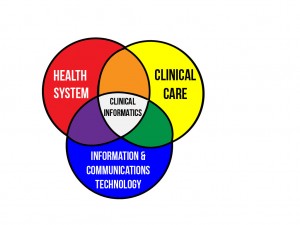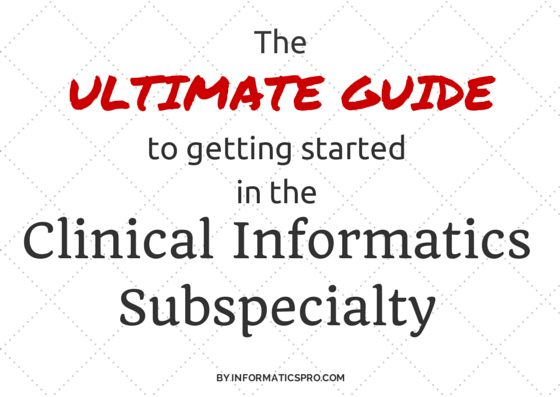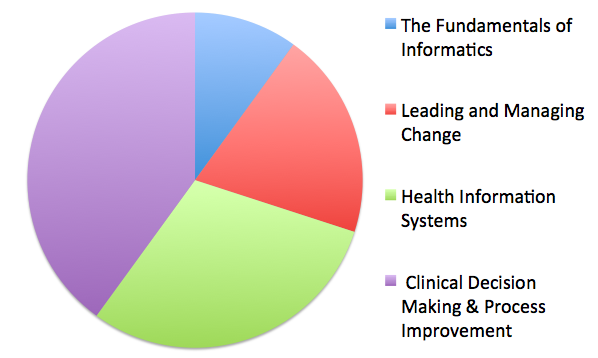In this post, we’ll introduce you to the clinical informatics subspecialty, what becoming a board-certified clinical informaticist can do for you, and how you can go about getting this second board certification. We’ll cover the following three topic areas:
- What Clinical Informatics Is and Why You Need to Get Into It
- Applying for the Exam
- The Exam
Assuming you are a physician with some work experience in IT, it’s relatively easy to get started on your second board certification. But what are we waiting for, let’s get into it.
1. What Clinical Informatics Is and Why You Need to Get Into It
What is Clinical Informatics?
Clinical Informatics is the application of informatics, clinical knowledge, and technology to continuously improve healthcare systems, services, and outcomes. Its kind of like all things clinical plus all things IT rolled up into one interdisciplinary ball and coated in management and leadership.

Clinical informatics is at the intersection of the health system, clinical care, and information and communications technology.
According to AMIA, “Clinical informaticians use their knowledge of patient care combined with their understanding of informatics concepts, methods, and tools to:
- assess information and knowledge needs of health care professionals and patients,
- characterize, evaluate, and refine clinical processes,
- develop, implement, and refine clinical decision support systems, and
- lead or participate in the procurement, customization, development, implementation, management, evaluation, and continuous improvement of clinical information systems“.
Why Should I Become a Clinical Informaticist?
You would enjoy clinical informatics if you have a love for improving systems – both clinical and human – to affect change in orders of magnitude larger than you are doing now. Clinical informatics also allows you:
- A more practical work-life balance with option to practice
- Clinical informatics work follows a more typical 9-5 workday. Many clinical informaticists have the option to take clinical day(s) every week.
- A similar or even higher salary depending on what kind of position you take
- According to the 10th annual AMDIS-Gartner survey on CMIOs, the average salary of a CMIO in 2013 was $326,000.
- The ability to impact more people at once
- Working with patients one on one can be extremely rewarding. However, implementing a new clinical information system that improves patient outcomes can impact hundreds, if not thousands of patients.
- Working with new technology
- If you’ve ever complained about your EHR (who hasn’t), you can now use your tech skills to take matters into your own hands and transform the systems you so despise into something that works better for you, your colleagues, and their patients.
- Re-engineer workflows for efficient health care
- You know that some of your processes are completely inefficient. Almost laughably so. Have you ever just wanted to tear them down and start from scratch? Clinical informatics encourages this and teaches you how to do this. Buh-bye duplicate work and bottlenecks.
Better work-life balance, getting to play everyday with new technology, improving inefficient systems and workflows, and impacting a whole lot of people all while putting your clinical skills to good use…..what more could you ask for out of a clinical subspecialty?
How Does Clinical Informatics Differ from Biomedical Informatics?
Biomedical informatics is the science of biomedical data, information, and knowledge and it’s application to improving health.
Clinical informatics is the use of clinical data, information, and knowledge by clinicians to improve health care.
The difference between clinical informatics and other informatics subspecialties is who practices them. Clinical informatics is typically practiced by clinicians and has a greater focus on the making the health care system better through more efficient workflows, IT systems, and clinical decisions. It also has a greater slant towards leadership and management.
What is the Clinical Informatics Subspecialty?
The clinical informatics subspecialty is a medical subspecialty sponsored by the American Board of Preventive Medicine (ABPM).
It underwent development of its core content in 2007 and was formally recognized by the American Board of Medical Specialties (ABMS) in 2011. The inaugural class of board certified clinical informaticists passed their board certification exam in fall of 2013.
This year marks only the second class of board certification clinical informaticists. In 2018 a fellowship in informatics will be required to obtain certification, so if you have the required work experience, it is in your best interest to apply while you still can without needing fellowship experience.
What Kind of Career Options Does a Clinical Informaticist Have?
Clinical informaticists can work anywhere that IT and clinical knowledge touch. Some common positions for clinical informaticists include:
- Chief Medical Information Officers (CMIO)
- Chief Medical Officers (CMO)
- Chief Information Officers (CIO)
- Chief Executive Officers (CEO)
- Researchers
- Vendor representatives
- Consultants
- Professors
- Fellowship directors
- and anything else where a leader is needed to integrate medicine with IT
2. Applying for the Exam
What Do I Need to Do To Apply to Become a Clinical Informaticist?
To meet the minimum requirements to apply to sit for the exam, each candidate is required to have
- an MD or DO from an acceptable medical school
- a valid medical license
- an existing board certification recognized by ABMS
- either 24 months in an informatics fellowship or three years of experience in informatics
Assuming you have these qualifications, you can then move ahead in the application process. A finished application includes the following:
- A completed and paid application
- Photocopies of your current medical license(s)/license renewal(s) that show expiration date.
- If applicable – A photocopy of transcripts for applicable informatics or graduate coursework
- If applicable – A photocopy of fellowship curriculum
- Verification for each clinical informatics activity listed in your application
- One Reference Letter Your reference must answer the following questions. See here for the format.
- How long have you known the applicant and in what capacity?
- What is the most recent period of time in which you have had direct contact
with the applicant? - Please describe the performance of the applicant, including clinical abilities if
applicable. - Please describe the professional conduct and ethics of the applicant?
- List any additional comments/information you may have below.
- Reference letter writer’s contact information, specialty and # of years in specialty.
- A copy of your Curriculum Vitae
Documentation can be submitted to [email protected]. For a more in-depth explanation, check out the requirements for eligibility here.
What Should My Timeline Look Like?
2014’s online was open for three months from March 1st to June 1st. The actual test was given the third and fourth week of October.
We would recommend registering for the exam as soon as you’re approved to. Having a hard test date may make the exam seem more “real” and force you to study.
How Do I Determine if I’m Eligible?
Assuming you have an MD/DO from an eligible school, a valid license, and board certification, the work experience requirements can be a little iffy to understand.
The requirements state the following for eligible work experience (emphasis ours):
Three years of practice in Clinical Informatics is required. Practice time must be at least 25% of a Full-Time Equivalent (FTE) to be considered. Practice time need not be continuous, however, all practice time must have occurred in the five-year interval immediately preceding application for certification.
Practice must consist of broad-based professional activity with significant Clinical Informatics responsibility. Documentation of Clinical Informatics research and teaching activities may also be submitted for review.
Verification is required that the equivalent of at least 3 years of an individual’s professional time has been devoted to the practice of clinical informatics during the five years prior to application for the examination. A person or persons who are knowledgeable about the applicant’s practice, such as the chief of staff, the applicable department chair, the director of a related Clinical Informatics training program, or the director of the clinical informatics program in the related institution must complete the verification. Completion of the verification by a partner or practice associate is not acceptable. The verification form will be available at the time of application.
Unfortunately, there’s no exact way to know if you’re eligible. Some positions may be more clear cut such as a CMIO, Clinical Informatics Analyst, or CIO in a health care company. Other experience such as clinical champion, systems analyst, teacher, researcher, or project manager may depend on the details of the position.
You may want to contact AMIA or contact ABPM prior to completing your application if you have any questions regarding your experience.
If I’m Not Eligible, What Can I Do?
If you do not have the required experience to apply, there are two things you can do. The first is to get more experience. You could do this by taking a new position, asking for specific informatics responsibilities within your current position, or volunteering to do informatics related work for your organization.
Another option is to pursue a fellowship in informatics. There aren’t a ton of ACGME accredited programs right now, but they’re slowly and steadily increasing in numbers. If you’re looking for a list of fellowships, you can check out our list here.
How Much Does It Cost?
Unfortunately, the clinical informatics certification does not come cheap. You can expect to pay the following fees if you plan to apply:
- $555 application fee (non-refundable)
- $1,750 examination fee
- Late fees range from $400-$1,600 depending on how late you are
- Other fees: $25 for bank returned checks, $50 for late exam cancellations
All in all, expect to shell out at least $2,305 for certification. Note that this does not include any costs for test prep – more on that later.
For the most current registration costs and information on the exam, see the ABPM website.
How Do I Complete My Application?
Registration is fairly straightforward. Registration can be completed through the ABPM’s clinical informatics online application. Pathologists must register through the ABPath website.
3. The Exam
What is Covered on the Clinical Informatics Subspecialty Board Exam?
The exam covers all of the clinical informatics core content from ABPM. The core content is apparently based on these books. However, many of them are outdated. We’d think you would do better by checking out this reading list and studying the sites listed in our “The Best Free Resources For The Clinical Informatics Exam” which you can get by signing up for our email list in the sidebar. There are four major components to the exam:
- Fundamentals in Informatics
- Leadership and Management
- Clinical Decision Making and Workflow Re-Engineering
- Clinical Information Systems
Some topics covered are “easier” – think group communication and history of informatics. Others are more complex – like SNOMED, HL7, SQL, and CDS.
If you’d like to see an overview of all of the topics covered, check out our mindmap.
What is the Test Like?
The exam is a computer-based exam consisting of 200 equally weighted multiple-choice questions with a four hour time limit. There are no penalties for guessing or leaving an answer blank. The test covers everything from project management and informatics ethics to decision models and SQL programming.
Questions are Distributed As Follows
10% is on The Fundamentals of Informatics
20% is on Leading and Managing Change
30% is on Health Information Systems
40% is on Clinical Decision Making & Process Improvement
Tests are taken at PearsonVUE locations across the country. If you’ve never taken a test at one of their centers before, make sure you SHOW UP EARLY and bring MULTIPLE forms of PICTURE ID. Seriously, these people are crazy. No test for you if you show up late without proper id.
How Can I Start Studying for the Exam?
There are a couple of options to study for the exam:
Self-study: Free. There are a whole bunch of free resources out there that should cover all of the material. However, finding it and putting it all together may be a bit time-consuming
AMIA Board Review: Online $1,495, Simulated Practice Exam Only $449, in-person review: $2K++??
InformaticsPro: Exam Review Book: $299, Review book + full practice exam: $499 (coming soon)
We’re of course a little biased towards the InformaticsPro option, as we offer it and think it covers everything you need to know in an easy to-read, easy-to-understand format. But, no matter which option you choose the effort you put in will be reflected in your score. We hope to come out with a post comparing all the options at a later date, so stay tuned.
What Should I Do Once I Pass the Exam?
Um, celebrate??!! Is this even a question??
Where Can I Find More Resources?
There are many resources available on our “Resources” page. There you’ll be able to find lists of professional organizations, conferences, books,
You can also sign-up for our email list to get posts like this one delivered straight to your inbox.

